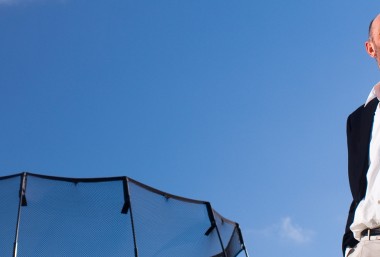Robust intellectual property protection has stopped others imitating an internationally successful Kiwi invention.
Remember those carefree moments when you were a kid, bouncing high on a trampoline and soaring through the air? Remember being catapulted headfirst into the springs and breaking your arm on the metal frame? Fun times.
Like most parents, Dr Keith Alexander didn't want this scenario for his children. Nor did his wife, who vetoed trampolines because they were just too dangerous.
So, Alexander, an associate professor of mechanical engineering at the University of Canterbury, set about designing a safer alternative. What he eventually came up with was a soft-edge trampoline that in place of the traditional springs uses fibreglass rods set into a frame beneath the mat, and has a fine-weave 'no climb' net that makes falling off a thing of the past.
His Springfree trampoline is now sold around the world, to the relief of parents and trauma staff everywhere.
Alexander recognised early on that he'd created something unique,and quickly secured a US patent for his design. That initial patent, obtained in the late 1990s, was the start of a carefully considered intellectual property strategy, says Greg West-Walker, a partner and patent attorney at intellectual property specialist AJ Park.
'Keith conceived of a completely new type of trampoline,' says West-Walker. 'He realised that he really had quite a different invention on his hands and believed in its potential, so he pushed for patenting. If he hadn't done that, there would be no unique product today.'
AJ Park initially worked with Alexander and Canterprise, the commercialisation arm of the University of Canterbury, advising them on a suitable IP strategy. The firm now continues to advise Doug Hill who owns Springfree NZ and the licence to use the intellectual property here and in a number of other territories.
'Springfree took a sophisticated approach to IP and had quite an international outlook from the start,' says West-Walker. 'There's now a portfolio of nearly 15 patents that cover the Springfree, with applications still in process - that's a strong patent thicket around the product.'
The IP strategy is ongoing, explains Hill, because of Alexander's singular drive to solve design issues and continually devise solutions to new 'problems', creating additional intellectual property opportunities.'AJ Park has been instrumental in our IP programme evolving as it has,' says Hill. 'From early on there was a high level of trust between Greg and Keith. Greg is thorough and pragmatic, and his attitude is to always look at the value each patent would bring and how hard it would be to defend.
AJ Park has been instrumental in our IP programme evolving as it has,' says Hill. 'From early on there was a high level of trust between Greg and Keith. Greg is thorough and pragmatic, and his attitude is to always look at the value each patent would bring and how hard it would be to defend.
- Doug Hill, Springfree
Hill says it's been important to work with experts who have the skills and experience to implement an effective IP strategy.
'They've made it easy. There was a consultative approach that made you confident that you could have impartial dialogue about the value proposition, and that was highly useful. It opened up the forum to discuss the most effective strategy with them.'
West-Walker says it's great working with clients who understand the importance of robust IP protection.
'My role isn't simply to file patents for them, but to make sure that before they press the 'spend' button, we all know what the prospects of success are.'
The strength of Springfree's patent protection was tested recently when a Chinese company began manufacturing copies of their product. Hill came across their website selling knockoff Springfree trampolines with a component design that breached their Chinese patent.
'They'd built a credible copy,' says Hill. 'Initially, we questioned the value of trying to prosecute the infringer. But, with AJ Park's support, we decided to take action and took an infringement prosecution against them. The Chinese authorities acted quickly and aggressively, and the manufacturer was shut down.'
West-Walker says products like the Springfree are prime targets for copying as competitors lose market share.
'With a successful product like this, other manufacturers will work through the patents to see if there are any gaps in them,' says West-Walker. 'Springfree's strong IP has been a great deterrent to copying.'
By investing money in the right patents, he says, you're not only protecting your product from counterfeiters, you're also potentially saving money on future litigation against those infringing your rights.
'If you have an innovative product, you have to think early and get good advice,' West-Walker recommends. 'Generally, once the product is on the market it's too late. If you really believe in it, you have to think hard about spending money on IP before it goes to market. Springfree's most valuable patent is undoubtedly the original one that Keith filed in the US.'
West-Walker suggests anyone who believes they have a novel idea but is unsure about its worth or how to protect it should invest in an initial chat with an intellectual property expert.
'Come and see us or let us come and see you for an hour or two. You can tell us about your innovation and we'll give you some advice.'
An edited version of this client story appeared in the July/August issue of Idealog magazine.
Photo credit Idealog.
